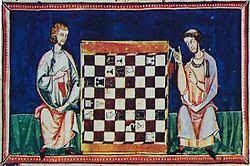By Viviana Premazzi, Founder of Global Mindset Development ,Eliana Zuliani, Giulia Cianciulli and Enrico Bertolaso

We help organizations to work effectively across cultures. We help people to learn cross-cultural communication and negotiation strategies and to develop competencies to lead and work in an intercultural team. Moreover, we mentor companies during the internationalization process, helping them to build and understand the opportunities and challenges of the global market.
Probably now you are wondering: how is this linked to chess?
But the right question here is: what does chess teach us about cultures?
Playing chess can connect cultures and people. It is based on intellectual challenges and logical skills. People’s ability and their willingness to learn and improve is the only thing that matters.
Interestingly enough chess was created between India and Persia centuries ago, like most of the religions in the world had their origin in that geographical and cultural area.

In particular, chess has been used to teach war strategy and leadership to kings and rulers. Leading a kingdom, an army or a company as well as playing chess requires, as a matter of fact, strategic thinking and a global mindset.
- Strategic thinking and managing cultural differences
Playing chess can be used with an educational purpose. It can teach you how to manage a problem, how to find a solution, evaluating different strategies and moves.
The game, indeed, can help to develop problem solving skills, taking into consideration costs and benefits and consequences of single action. It also improves accountability skills.

In a multicultural organization you have to manage cultural differences and consider their intersectionality. There’s no one approach that fits all. A good manager or an organization committed to diversity and inclusion are able to evaluate various approaches. Then they choose how to act in a specific situation, considering all the consequences and the whole scenario. Diversity and inclusion should be part of the business strategy like a single move in chess cannot be considered isolated from the whole game.
2. A Global Mindset
When you play chess, you have to have a bird-eye on the chessboard. You have to look at all your pawns and your opponent’s ones. This is what in business and, in particular in intercultural management, we call Global Mindset. The Global Mindset considers the broad perspective, not only your single organization, your region or your country. It is being able to see everyone in their potential and their differences and see where and how you can “use them” for the benefit of the organization and the game.
3. Chess for breaking down walls
Almost since its origin, chess has affirmed itself as a democratic game, it is not only for the elite but everyone can play and learn strategies and skills. It started in the Indian sub-continent then came to Europe and now is played internationally online and in-person. It is based on fair played and equal opportunities.
4. One last tip: Be the Knight!
The knight’s move is distinctive and unique. Whereas all the pieces move in straight lines just in one single direction, the knight moves in an “L-Shape”. It can move two squares horizontally and one vertically and vice-versa.

We wish this kind of movement in your life! How can you be and move like the knight?
When you work in multicultural realities, remember to show your main direction but also to consider the other possible paths. The more you know about the other’s perspective, their skills and characteristics, the role they can have in the game, the more you can develop a winning team, committed and ready to succeed.
Last but not least: because of its movement the knight starts from a color square and ends up on another one. Being like a knight for us means also building your personal journey without the fear of changing your context!
For more about the global chess community, check out National Master Evan Rabin’s Premier Five Chess Travel tips.


I agree that we should have to have a bird-eye on the chessboard. Thanks for sharing these effective strategies
Play responsibly and enjoy endless entertainment!
Pingback: shelf life of psychedelic mushrooms
Pingback: micro dosing chocolate
Pingback: ks quik 2000
Pingback: gunpowder
Pingback: אחסון אתרים
pleasant post, stay aware of this fascinating work. It truly regards realize that this subject is being secured likewise on this site so cheers for setting aside time to talk about this!
Pingback: carts vape
Pingback: auto detailing
Pingback: สมัคร LSM99 เริ่มต้นเดิมพันขั้นต่ำ 1 บาท
Pingback: Buy Guns With Bitcoin @ Hidden Weaponry
Pingback: hostel bangkok
Pingback: 토토무료머니
Pingback: เว็บพนันเกาหลี
Pingback: ผู้ผลิต AdBlue รายแรกของประเทศไทย
Pingback: rainbow six siege renown hack xbox one
Pingback: once human time2win
Pingback: arena breakout infinite hacks
Pingback: ไก่ตัน
Pingback: เว็บรวมเกมสล็อต
Pingback: บาคาร่าเกาหลี
Pingback: free webcams
Pingback: ออกแบบตกแต่งบ้านหรู
Pingback: สล็อตวอเลท เว็บตรง ระบบการเงินแม่นยำ
Pingback: รับนำเข้าสินค้าจากจีน
Pingback: gym equipment shop
Pingback: last deals
Pingback: สล็อตออนไลน์เกาหลี
Pingback: ยางยอย
Pingback: SBOBETCLUB168 ทางเข้าแทงบอลยอดฮิต ปิดแล้วย้ายมาเล่นที่ LSM99LIVE ดีไหม
Pingback: ufabet777
Pingback: 토토사이트
Pingback: som777
Pingback: ของพรีเมี่ยม
Pingback: click here
Pingback: เว็บตรงฝากถอนง่าย
Pingback: เว็บพนันออนไลน์เว็บตรง
Pingback: รู้จัก huayinter
Pingback: สั่งของจากจีน
Pingback: ขอใบอนุญาตโฆษณาอาหาร
Pingback: Cbd flower shop uk
Pingback: สมาชิกของทางเว็บ วีเอ็ม9
Pingback: sweet bonanza slot
Pingback: หนังใหม่พากย์ไทย
They consistently exceed expectations by combining expert knowledge with a genuine commitment to client goals.구글찌라시 They combine deep knowledge with a client-first mindset, ensuring every engagement is productive and trustworthy.
Thankyou for sharing the data which is beneficial for me and others likewise to see.